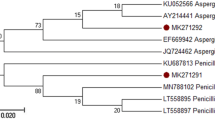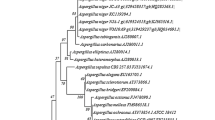Abstract
Aspergillus flavus, Aspergillus fumigatus, Aspergillus niger, Helminthosporium oxysporium, and Penicillium frequestans isolated from common Nigerian agricultural residues like cassava, yam, banana, and plantain peels and brewery spent grains (BSG) were screened for their ability to produce β-amylase and amyloglucosidase using submerged and solid-state cultivation regimens. Enzyme activity (EU) was determined by estimating the amount of reducing sugars produced as a result of the action of crude enzyme solutions on buffered starch solution. Results showed that A. niger liberated the highest level of β-amylase (33.2 EU) on plantain peels medium using the static cultivation method, while it produced the highest amount of amyloglucosidase (29.8 EU) on yam peels substrate with solid-state cultivation regimen. Plantain peels favored β-amylase production more than the other tested wastes supporting production of 33.2 and 9.8 EU of the enzyme in A. niger under solid-state and static cultivation methods, respectively. Yam peels favored liberation of 15.3 EU amyloglucosidase in each of the solid-state and the static cultivation regimens. Production of β-amylase on BSG, yam, banana, and plantain peels was not significantly facilitated by static cultivation method (p > 0.05), while solid-state cultivation regimen favored amyloglucosidase production on cassava peels and BSG (p < 0.05). Optimal production yield of β-amylase and amyloglucosidase were 16.6 and 14.9 EU g−1 on plantain and yam waste media by the mold.
Similar content being viewed by others
References
Aiyer, P. V. (2005). Amylases and their applications. African Journal of Biotechnology, 4(13), 1525–1529.
Akinyosoye, F. A., Adeniran, H. A., & Oboh, G. (2004). Effects of cultural changes on Amylolytic activities of Rhizopus stolonifer isolated from decomposing agro-industrial wastes. Nigerian Journal of Biochemistry and Molecular Biology, 19(1), 41–46.
Alexander, R. J. (1998). Sweeteners: Nutritive pp. 17–102. Minnesota: Eagan.
Ali, S., Mahmood, S., Alan, R., & Hossain, Z. (1989). Culture conditions for production of glucoamylase from rice bran by Aspergillus terreus. MIRCEN Journal of Applied Microbiology and Biotechnology, 5, 525–532.
Alli, A. I., Ogbonna, C. I. C., & Rahman, A. T. M. F. (1998). Hydrolysis of certain Nigerian starches using crude fungal amylase. Nigerian Journal of Biotechnology, 9(1), 24–35.
AOAC (1994). Official methods of analysis of the association of official analytical chemists. In W. Horwitz (Ed.), Association of Official Analytical Chemists Publisher 12th edition. Washington DC: AOAC.
Bhumibhamon, O. (1986). Glucoamylases of a fungus isolated from a rotting cassava tuber. MIRCEN Journal, 2, 473–482.
Bruton, C. J. (1983). Large scale purification of enzymes. In B. J. Hartley, T. Atkinson, & M. D. Lilly (Eds.), Industrial and diagnostic enzymes (pp. 249–261). London: The Royal Society.
Fossi, B. T., Tavea, F., & Ndjouenkeu, R. (2005). Production and characterization of a thermostable amylase from ascomycetes yeast strain isolated from starchy soils. African Journal of Biotechnology, 4(1), 14–18.
Harrigan, W. F., & McCance, M. E. (1976). Laboratory methods in food and dairy microbiology pp. 55–452. London: Academic.
Israel, A. U., Obot, I. B., Omoren, S. A., Mkpenie, V., & Asuquo, J. E. (2008). Production of cellulosic polymers from agricultural wastes. E-Journal of Chemistry, 5(1), 81–85.
Jalc, D., Nerud F., & Siroka, P. (1996). The effect of white rot basidiomycetes on chemical composition and in vitro digestibility of wheat straw. Folia Microbiologica (Praha), 41(1), 73–75.
James, C. S. (1995). Analytical chemistry of foods pp. 38–137. London: Blackie.
Kuhad, R. C., & Singh, A. (1993). Enhanced production of cellulases by Penicillium citriniumin in solid state fermentation of cellulosic residue. World Journal of Microbiology and Biotechnology, 9, 100–101.
McLauchlin, J., & Little, C. (2007). Hobb ’ s food poisoning and food hygiene, seventh edition pp. 89–91. London: Arnold.
Menoncin S., Domingues, N. M., Freire, D. M. G, Toniazzo,G, Cansian, R. L. Oliveira, J. V., Luccio, M. D, de Oliveira, D., & Treichel, H. (2008). Study on extraction, concentration and partial characterization of lipases obtained from Penicillium verrucosum using solid state fermentation of soyabean bran. Food and Bioprocess Technology. doi:10.1002/s11947-008-0104-8.
Metwally, M. (1998). Glucoamylase production in continuous cultures of Aspergillus niger with emphasis on growth parameters. World Journal of Microbiology and Biotechnology, 14, 113–118.
Miller, G. L. (1959). Use of dinitrosalicylic acid reagent for determination of reducing sugar. Analytical Chemistry, 31, 426–428.
Oso, B. A. (1992). Principles of industrial waste mangagement in Nigeria. Proceedings of Workshop on Industry and the Nigerian Environment. Ibadan, Nigeria: U.C.H.
Radley, J. A. (1976). Industrial uses of starch and its derivatives pp. 51–115. London: Applied Science Publishers.
Rama Mohan Reddy, P., Swanny, M. V., & Seenayya, G. (1998). Purification and characterization of thermostable beta-amylase and pullulanase from high-yielding Clostridium thermosulfurogenes SV 2. World Journal of Microbiology and Biotechnology, 14, 89–94.
Ramadas, M., Holst, O., & Mattiasson, B. (1996). Production of amyloglucosidase by Aspergillus niger under different cultivation regimens. World Journal of Microbiology and Biotechnology, 12, 267–271.
Rani, R. R., Jana, S. C., & Nanda, G. (1994). Saccharification of indigenous starches by Beta-amylase of Bacillus megaterium. World Journal of Microbiology and Biotechnology, 10, 691–693.
Riviere, J. (1977). The formation and extraction of fermentation products. In: Industrial applications of microbiology pp. 59–104. New York: Wiley.
Robledo, A., Aguilera-Carbo, A., Rodriguez, R., Martinez, J. L., Garza, Y., & Aguiar, C. N. (2008). Elagic acid production by Aspergillus niger in solid state fermentation of pomegranate residues. Journal of Industrial Microbiology and Biotech, 35, 507–513. doi:10.1007/s10295-008-0309x.
Sani, A., Awe, F. A., & Akinyanju, J. A. (1992). Amylase synthesis in Aspergillus flavus and Aspergillus niger grown on cassava peel. Journal of Industrial Microbiology, 10, 55–59.
Shen, G. J., Saha, B. C., Lee, Y. E., Bhatnagar, L., & Zeikus, J. G. (1988). Purification and characterization of a novel thermostable beta-amylase from Clostridium thermosulfurogenes. Biochemical Journal, 254, 835–840.
Trezek,G. J., & Golueke,C. G. (1976). Availability of cellulosic wastes for chemical or biochemical processing. In: Biochemical engineering—energy, renewable resources and new foods, AIChE Symposium Series No. 158 (72) 52–54.
Xu, H., Sun, L., Zhao, D., Zhang, B., Shi, Y., & Wu, Y. (2008). Production of alpha amylase by Aspergillus oryzae as 3951 in solid state fermentation using spent brewing grains substrate. Journal of Science of Food and Agriculture, 88(3), 529–535.
Acknowledgment
The authors wish to acknowledge a grant made available by URC, Obafemi Awolowo University, Ile-Ife, Nigeria, which assisted in the course of the research.
Author information
Authors and Affiliations
Corresponding author
Rights and permissions
About this article
Cite this article
Adeniran, H.A., Abiose, S.H. & Ogunsua, A.O. Production of Fungal β-amylase and Amyloglucosidase on Some Nigerian Agricultural Residues. Food Bioprocess Technol 3, 693–698 (2010). https://doi.org/10.1007/s11947-008-0141-3
Received:
Accepted:
Published:
Issue Date:
DOI: https://doi.org/10.1007/s11947-008-0141-3




